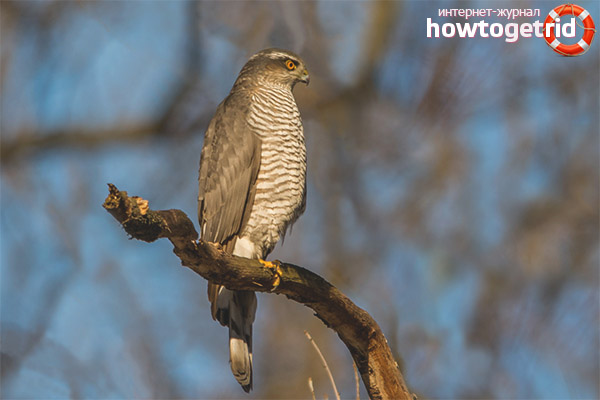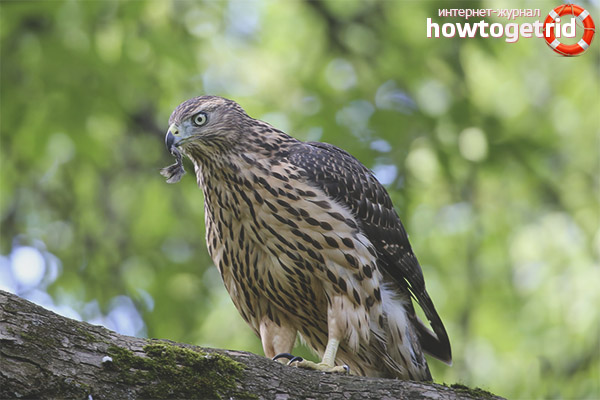The content of the article
Have you ever seen a crow flock noisily and nimbly chasing a small bird, no more than the crows or jackdaws themselves? A bird that tries to escape from its pursuers is a sparrow hawk. In autumn, when hawks begin to wander, their flocks are quite large even in the city. You can recognize these birds by a slender and graceful figure, an elongated tail, which is extended back.
The hawk is not afraid of commotion in a flock of birds, leaving them leisurely, often changing the flight vector, turning over in the air. Sometimes, even grabbing someone from catching up, which causes some panic and chaos. Usually, the quail hawk feeds on small birds. Males, which are not very large, can catch carduelis, kings, sparrows and other small birds, and larger females are content with pigeons, starlings, etc.
Hunting methods
As usual, the hawk plucks the caught prey, sometimes without even killing it, but if at this moment he is disturbed by something, the predator will leave an unfortunate prey. Usually this bird settles with prey on a small hill, and as a result of the meal, feathers, bones, beak, claws and a bird's skull remain at the place of the meal.
When a hawk hunts for a variety of small animals and birds, it can sometimes become a victim of a larger and more dangerous predator. Martens attack him at night, and in the daytime, another species of hawk is the goshawk.
Behavior features
This predator is quite careful and silent. It flies freely and quietly between bushes and trees or right near the surface of the earth, near houses and buildings. Sometimes it is possible to hear his short sharp cry of "Ki-kik-ki". When the hawks begin their breeding season, they begin to cry more often. The visual acuity of the quail eagle: its eyes are large, directed strictly forward, and this allows to achieve a greater breadth of view.
For nesting, the hawk usually chooses forest edges, small groves, and forest belts. In mountainous areas, he can build nests at an altitude of up to 2 km, but certainly in the forest zone. In cold periods and in winter it can be found in parks or forest areas of the city. The hawk's habitat: the European part from England to Spain, the western part of Siberia, Central Asia, Africa, p / ο Crimea.
Nests

Sparrowhawks become ready for breeding by the age of the year or a little earlier. Birds use nests once built for several years. A pair may also have several nests that can be used alternately at different times. The nest is a small, loose and slightly chaotic structure of wood branches.The nest tray is deep enough, because the edges of the building are raised up, the hawk erects the lining from thin branches and tree needles. Often the nest is located in a spruce or pine fork, not so often - on aspens or birches, at a height of up to 8 meters.
The female and the male are engaged in the construction of the nest together. The hawk lays eggs quite late, closer to the beginning of May. In the clutch an average of about 5-6 eggs, which have a matte white shade, covered with spots and specks of brown-dark color. If, due to some factors, the clutch dies, then the female is forced to postpone the future offspring again. Hatching takes a little more than one month.
Breeding
The process of incubation begins from the moment the first egg appears, therefore, all offspring are of different ages. In the light, they hatch closer to the first half of July, and before the age of ten days, each chick needs heating. During this period, the female can not engage in hunting, therefore, such a duty rests with the male. If during the time the female warms up the chicks, she dies, then the hawk will continue to bring food to the nest, but he does not know how to feed the offspring. Therefore, if small hawks already know how to tear meat and feed on their own, they survive, otherwise they die.
As soon as the chick thermoregulation returns to normal, the female also begins to fly out of the nest to hunt. Offspring need a lot of food, as they need a source of energy for proper development. Therefore, sparrow hawks try to catch as much prey as possible than during non-breeding time. At the same time, both the female and the male try to leave the nesting area for at least 5-6 kilometers.
Pre-migration period

A month later, when the chicks are already growing up, but do not have fully formed tail feathers and feathers, they can already crawl out of the nest and be located in close proximity to it. Only by the age of five weeks the chicks begin to learn to fly. Females develop faster than males. After a couple of weeks, the offspring is already scattered from its native nest, already knowing how to chase and catch prey. Adult individuals at the end of nesting begin to molt: the process begins with feathers located on the wings and ends with covering feathers. The whole process takes an average of two to three months. Closer to the beginning of autumn, until October, birds living in the northern part begin to fly to the southern countries. On average, a hawk can reach speeds of up to 40 kilometers per hour during migration.
Entertaining facts
Also, the Sparrowhawk has a poor ability to tame, so they are almost never used to participate in falconry. The famous prose writer A. Green once was able to get and tame a hawk chick, who gave the name Gul-Gul. The domesticated predator was never able to learn how to catch prey, so it quickly died after it was released into the wild. This chick became a prototype that participated in the work of the "Touchless", which was never completed, and in a story entitled "The Story of a Hawk."
Video: Sparrowhawk (Accipiter nisus)










Submit